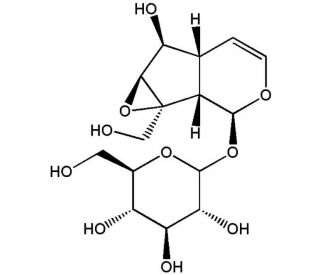

Catapol (CAS 2415-24-9)
QUICK LINKS
Catapol, a naturally occurring chemical compound, has garnered significant attention in scientific research due to its diverse pharmacological properties and applications. Primarily derived from the plant Catapodium rigidum (L.) C.E. Hubb., Catapol belongs to the class of iridoid glycosides, characterized by a cyclopentan[b]pyran ring system. Research suggests that Catapol exerts its effects through multiple mechanisms, including antioxidant, anti-inflammatory, and neuroprotective actions. Studies have demonstrated Catapol′s ability to scavenge free radicals and inhibit oxidative stress-induced damage, thereby protecting cells and tissues from oxidative injury. Furthermore, Catapol exhibits anti-inflammatory activity by modulating various pro-inflammatory mediators and signaling pathways, such as nuclear factor-kappa B (NF-κB) and mitogen-activated protein kinases (MAPKs), leading to the attenuation of inflammatory responses. Additionally, Catapol has been investigated for its neuroprotective effects against neurodegenerative disorders, including Alzheimer′s disease and Parkinson′s disease. Studies have shown that Catapol can enhance neuronal survival, promote neurite outgrowth, and mitigate neuronal apoptosis, suggesting its potential as an agent for neuroprotection. Furthermore, Catapol has been explored for its antimicrobial, antiviral, and antitumor activities, highlighting its broad spectrum of biological effects and its promise as a valuable tool in biomedical research. Ongoing research continues to explain the molecular mechanisms underlying Catapol′s pharmacological actions and to explore its potential applications in various disease contexts.
Catapol (CAS 2415-24-9) References
- Catapol production in Chinese foxglove (Rehmannia glutinosa Libos.) hairy roots transformed with Agrobacterium rhizogenes ATCC15834. | Hwang, SJ. 2009. Methods Mol Biol. 547: 263-73. PMID: 19521851
- Amelioration of stroke-induced neurological deficiency by lyophilized powder of catapol and puerarin. | Liu, Y., et al. 2014. Int J Biol Sci. 10: 448-56. PMID: 24719562
- Triptolide-induced hepatotoxicity can be alleviated when combined with Panax notoginseng saponins and Catapol. | Zhou, L., et al. 2018. J Ethnopharmacol. 214: 232-239. PMID: 29277608
- Catalpol Exerts an Anti-Epilepticus Effect, Possibly by Regulating the Nrf2-Keap1-ARE Signaling Pathway. | Gao, J., et al. 2018. Med Sci Monit. 24: 9436-9441. PMID: 30592708
- Inhibitory effects of catalpol coordinated with budesonide and their relationship with cytokines and Interleukin-13 expression. | Zhu, H. and Wang, H. 2019. Am J Transl Res. 11: 6413-6421. PMID: 31737193
- Natural Products as Modulators of Nrf2 Signaling Pathway in Neuroprotection. | Moratilla-Rivera, I., et al. 2023. Int J Mol Sci. 24: PMID: 36835155
- Catalpol Alleviates Depression by Inhibiting NLRP3 Inflammasome via TLR4/MAPK/NF-Kb Pathway. | Liang, X., et al. 2023. Iran J Public Health. 52: 722-731. PMID: 37551177
- Catapol reduced the cognitive and mood dysfunctions in post-stroke depression mice via promoting PI3K-mediated adult neurogenesis. | Li, B., et al. 2023. Aging (Albany NY). 15: 8433-8443. PMID: 37647020
- Catapol attenuates the aseptic inflammatory response to hepatic I/R injury in vivo and in vitro by inhibiting the HMGB1/TLR-4/NF-κB signaling pathway via the microRNA-410-3p. | Feng, ZJ., et al. 2023. Mol Immunol. 164: 66-78. PMID: 37979473
- [Antibacterial action of the polymeric antiseptic catapol]. | Zaikina, NA., et al. 1994. Antibiot Khimioter. 39: 48-51. PMID: 7826176
Ordering Information
| Product Name | Catalog # | UNIT | Price | Qty | FAVORITES | |
Catapol, 50 mg | sc-285281 | 50 mg | $184.00 | |||
Catapol, 100 mg | sc-285281A | 100 mg | $306.00 |
